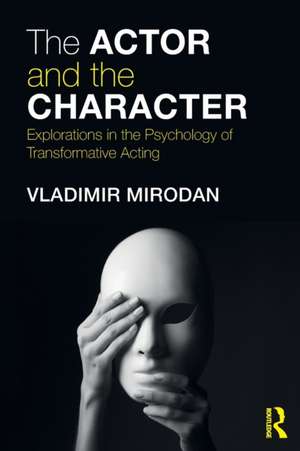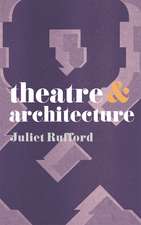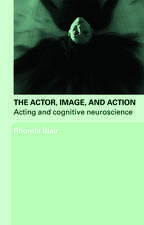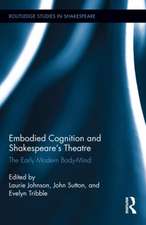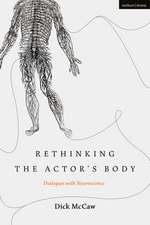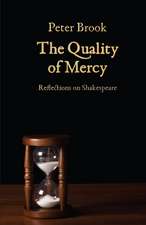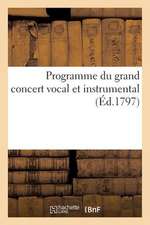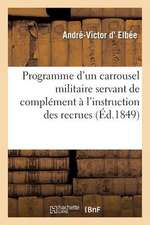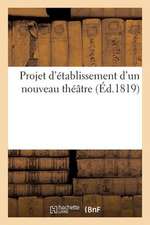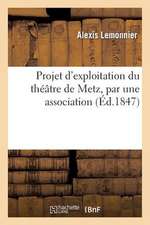The Actor and the Character: Explorations in the Psychology of Transformative Acting
Autor Vladimir Mirodanen Limba Engleză Paperback – 22 noi 2018
- Surveys the main debates surrounding the concept of dramatic character and – contrary to recent trends – explains why transformative actors conceive their characters as ‘independent’ of their own personalities.
- Describes some important techniques used by actors to construct their characters by physical means: work on objects, neutral and character masks, Laban movement analysis, Viewpoints, etc.
- Examines the psychology behind transformative acting from the perspectives of both psychoanalysis and scientific psychology and, based on recent developments in psychology, asks whether transformation is not just acting folklore but may actually entail temporary changes to the brain structures of the actors.
| Toate formatele și edițiile | Preț | Express |
|---|---|---|
| Paperback (1) | 287.08 lei 3-5 săpt. | +16.39 lei 6-12 zile |
| Taylor & Francis – 22 noi 2018 | 287.08 lei 3-5 săpt. | +16.39 lei 6-12 zile |
| Hardback (1) | 999.51 lei 6-8 săpt. | |
| Taylor & Francis – 27 noi 2018 | 999.51 lei 6-8 săpt. |
Preț: 287.08 lei
Nou
Puncte Express: 431
Preț estimativ în valută:
54.93€ • 57.35$ • 45.46£
54.93€ • 57.35$ • 45.46£
Carte disponibilă
Livrare economică 14-28 martie
Livrare express 27 februarie-05 martie pentru 26.38 lei
Preluare comenzi: 021 569.72.76
Specificații
ISBN-13: 9781138852525
ISBN-10: 113885252X
Pagini: 202
Dimensiuni: 156 x 234 x 18 mm
Greutate: 0.29 kg
Ediția:1
Editura: Taylor & Francis
Colecția Routledge
Locul publicării:Oxford, United Kingdom
ISBN-10: 113885252X
Pagini: 202
Dimensiuni: 156 x 234 x 18 mm
Greutate: 0.29 kg
Ediția:1
Editura: Taylor & Francis
Colecția Routledge
Locul publicării:Oxford, United Kingdom
Cuprins
Acknowledgements
A Note on Terminology
Chapter One – Introduction
PART ONE – The Idea of Character
Chapter Two An Independent Character
Chapter Three A Brief History of … Type
Chapter Four Friends for Life: Character and Literary Criticism
Chapter Five The Drama of No Character
PART TWO – Transformations in Body and Mind
Chapter Six Constructing the Character
Chapter Seven Psychologies: I – Trait, Type and Temperament
Chapter Eight Psychologies: II – Conflict and Energy
Chapter Nine Psychologies: III – Character on the Couch
PART THREE – The Melding of Actor and Character
Chapter Ten Imagining the Character
Chapter Eleven Experiencing the Character
Chapter Twelve Deception, Self-Deception and the Transformative Actor
Index
A Note on Terminology
Chapter One – Introduction
PART ONE – The Idea of Character
Chapter Two An Independent Character
Chapter Three A Brief History of … Type
Chapter Four Friends for Life: Character and Literary Criticism
Chapter Five The Drama of No Character
PART TWO – Transformations in Body and Mind
Chapter Six Constructing the Character
Chapter Seven Psychologies: I – Trait, Type and Temperament
Chapter Eight Psychologies: II – Conflict and Energy
Chapter Nine Psychologies: III – Character on the Couch
PART THREE – The Melding of Actor and Character
Chapter Ten Imagining the Character
Chapter Eleven Experiencing the Character
Chapter Twelve Deception, Self-Deception and the Transformative Actor
Index
Notă biografică
Vladimir Mirodan is a theatre director, Emeritus Professor of Theatre, and was Vice-Principal and Director of Drama at the Royal Conservatoire of Scotland and Principal of Drama Centre London. He has published on topics of acting psychology, as well as the theory and practice of acting.
Recenzii
"A rich and fascinating exploration of what happens as actors embody fictional selves […] accessible, grounded in professional practice and wide-ranging in scope."
- Rick Kemp, author of Embodied Acting: What Neuroscience Tells Us About Performance
"This is a remarkable book – not a handbook, but the fullest discourse in recent years regarding the complex processes undergone by the protean actor […] a combination of impeccably detailed research, perception and example […] it has inspired me to think anew about my own practice. Brilliant, profound and shot through with passion and humanity, it is a must for both theatre academics and actors who seek to think about their craft."
- Annie Tyson, Royal Academy of Dramatic Arts
"Mirodan’s study is such a rich and learned piece of research, that covers so much ground, and interrelates data and insights from so many disparate areas of inquiry. His intention - to challenge what may have become the complacent orthodoxy of the actor-in-action model – is carried through with an extraordinarily impressive range of scholarship. The Actor and The Character is an outstanding example of the way in which a cross-disciplinary approach to any subject can elicit striking new insights for the target discipline (in this case transformative character acting). It is a book I know that I shall return to again and again, and I have no doubt that my own practice will be deeply affected, at its root, as a consequence of reading it."
- Julian Jones, Stanislavski Studies
‘… a rich and fascinating exploration of what happens as actors embody fictional selves … accessible, grounded in professional practice and wide-ranging in scope.’
Rick Kemp, author of Embodied Acting: What Neuroscience Tells Us About Performance
‘This is a remarkable book – not a handbook, but the fullest discourse in recent years regarding the complex processes undergone by the protean actor… a combination of impeccably detailed research, perception and example… it has inspired me to think anew about my own practice. Brilliant, profound and shot through with passion and humanity, it is a must for both theatre academics and actors who seek to think about their craft.’
Annie Tyson, Royal Academy of Dramatic Arts
- Rick Kemp, author of Embodied Acting: What Neuroscience Tells Us About Performance
"This is a remarkable book – not a handbook, but the fullest discourse in recent years regarding the complex processes undergone by the protean actor […] a combination of impeccably detailed research, perception and example […] it has inspired me to think anew about my own practice. Brilliant, profound and shot through with passion and humanity, it is a must for both theatre academics and actors who seek to think about their craft."
- Annie Tyson, Royal Academy of Dramatic Arts
"Mirodan’s study is such a rich and learned piece of research, that covers so much ground, and interrelates data and insights from so many disparate areas of inquiry. His intention - to challenge what may have become the complacent orthodoxy of the actor-in-action model – is carried through with an extraordinarily impressive range of scholarship. The Actor and The Character is an outstanding example of the way in which a cross-disciplinary approach to any subject can elicit striking new insights for the target discipline (in this case transformative character acting). It is a book I know that I shall return to again and again, and I have no doubt that my own practice will be deeply affected, at its root, as a consequence of reading it."
- Julian Jones, Stanislavski Studies
‘… a rich and fascinating exploration of what happens as actors embody fictional selves … accessible, grounded in professional practice and wide-ranging in scope.’
Rick Kemp, author of Embodied Acting: What Neuroscience Tells Us About Performance
‘This is a remarkable book – not a handbook, but the fullest discourse in recent years regarding the complex processes undergone by the protean actor… a combination of impeccably detailed research, perception and example… it has inspired me to think anew about my own practice. Brilliant, profound and shot through with passion and humanity, it is a must for both theatre academics and actors who seek to think about their craft.’
Annie Tyson, Royal Academy of Dramatic Arts
Descriere
What are the physical and psychological processes which enable actors to create characters so different from themselves? To understand this phenomenon, Vladimir Mirodan provides a historical overview of the evolution of 'character' in Western theatre, and a stunning contemporary analysis of the theoretical implications of transformative acting.
